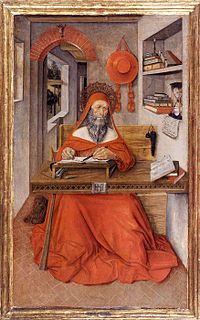Related Research Articles

Francesco Francia, whose real name was Francesco Raibolini was an Italian painter, goldsmith, and medallist from Bologna, who was also director of the city mint.

Francesco Cairo, also known as Francesco del Cairo, was an Italian Baroque painter active in Lombardy and Piedmont.

Altobello Melone was an Italian painter of the Renaissance.

Pietro Novelli was an Italian painter of the Baroque period, active mainly in Palermo. Also known as il Monrealese or Pietro "Malta" Novelli to distinguish him from his father, Pietro Antonio Novelli I. He was also nicknamed by contemporaries as the Raphael of Sicily.

Francesco Costa (1672–1740) was an Italian painter of the late-Baroque period, active mainly in his Native Genoa. He was the pupil of the painter Gregorio de Ferrari in Genoa, and later of Antonio Maria Haffner. He often painted with Giovanni Battista Revello. He painted in the Palazzo Grilli in Pegli, Genoa. He chiefly painted ornaments and quadratura. He painted Landscape with Rape of Europa which currently sits in the Uffizi museum.

Antonio Veneziano, was an Italian painter who was active mainly in Siena, Florence and Pisa, documented between 1369 and 1419.
Kaspar Anton von Baroni-Cavalcabo or Gaspare Antonio Cavalcabò Baroni was an Italian painter in a late Baroque period and style. During the greater part of his life he lived in Sacco, where he died. Many of his drawings are in the Library at Innsbruck.
Antonio Catalano, also called Catalani or il Siciliano, (1560–1630) was an Italian painter of the late-Renaissance and early-Baroque periods.
Antonio Catalani was an Italian painter of the late-Renaissance and early-Baroque periods. He might have been the same person as the painter Antonio Catalano of whom is said that he was born in Messina in 1583/1585 and died there in 1666.

Giacomo del Pò, also spelled del Po, was an Italian painter of the Baroque. He was born in Palermo, the son of Pietro del Pò who was also his teacher.

Luca Antonio Colomba (1674–1737) was a Swiss Baroque painter born at Arogno. His style was distinguished for its happy compositions and its careful design, as also for the delicate and tender colours. He painted in oil and fresco.

Pomponio Allegri was an Italian painter, the son of Correggio.
Ippolito del Donzello was an Italian painter and architect of the Quattrocento, active mainly in Naples.

Antonio da Fabriano was an Italian painter, active in the Region of Marche.

Giovanni Battista Sassi was an Italian painter, active mainly in Milan and other areas of Lombardy, who painted in a late-Baroque and Rococo style.
Francesco Nasini was an Italian painter of the Baroque period, active mainly in towns outside of Siena, Italy.
Francesco Floriani was an Italian painter, known for his portraits and sacred subjects.

Davide Antonio Fossati, a painter and etcher, was bom at Morcote, Ticino, Switzerland in 1708, and studied drawing under Vicenzo Maria Mariotti at Venice, and painting under Daniel Gran, with whom in 1723 he went to Vienna. In 1728 he painted the dining-hall in the monastery of St. Martinsberg at Pressburg; but in 1730 he returned to Venice, and in the next year executed the wall-paintings in the villa at Torre, near Este, as also in the nunnery of Santa Margaretta, near Lauis. He afterwards took to etching, but did not succeed at first. His death occurred at Vienna in 1795. His works as a painter are little known, but he has left among his later and happier efforts several etchings of landscapes and historical subjects after various masters.
Carlo Rosa 1613 – September 12, 1678) was an Italian painter.
Altobello is both a given name and a surname.
References
 This article incorporates text from a publication now in the public domain : Bryan, Michael (1886). "Altobello, Francesco Antonio". In Graves, Robert Edmund (ed.). Bryan's Dictionary of Painters and Engravers (A–K). Vol. I (3rd ed.). London: George Bell & Sons.
This article incorporates text from a publication now in the public domain : Bryan, Michael (1886). "Altobello, Francesco Antonio". In Graves, Robert Edmund (ed.). Bryan's Dictionary of Painters and Engravers (A–K). Vol. I (3rd ed.). London: George Bell & Sons.